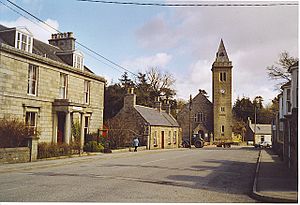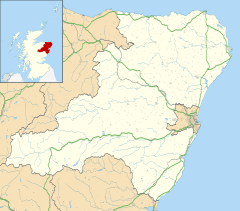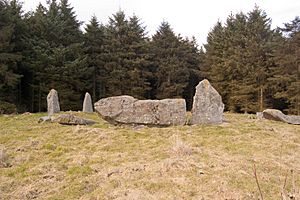Old Deer facts for kids
Quick facts for kids Old Deer
|
|
|---|---|
 Abbey Street in Old Deer, with the parish church in view |
|
| Population | 152 (2011) |
| OS grid reference | NJ976477 |
| Council area | |
| Lieutenancy area |
|
| Country | Scotland |
| Sovereign state | United Kingdom |
| Post town | PETERHEAD |
| Postcode district | AB42 |
| Police | Grampian |
| Fire | Grampian |
| Ambulance | Scottish |
| EU Parliament | Scotland |
| UK Parliament |
|
| Scottish Parliament | |
Old Deer (known as Scots: Auld Deer in Scots and Scottish Gaelic: Dèir in Gaelic) is a small village and parish located in Aberdeenshire, Scotland. In 2011, about 152 people lived there. The village sits on the A950, right by the Deer or South Ugie Water. It's about 10 miles (16 km) west of Peterhead and 2 miles (3.2 km) from Mintlaw.
The area around Old Deer has some interesting industries. People here are involved in making spirits (distilling) and beer (brewing). They also produce woollen items. There are also quarries where granite and limestone are dug out of the ground.
Not far from Old Deer, about 7 miles (11 km) to the west, is the village of New Deer. This village used to be called Auchreddie. To the north of New Deer, you can find the old ruins of Fedderate Castle.
Contents
What's in a Name?
The name Deer likely comes from the Pictish language. The Picts were an ancient people who lived in eastern and northern Scotland. The name probably comes from the word *deru, which means "oak tree." You can see similar words in other languages like Gaelic (dair or darach) and Welsh (derw).
A Look Back in Time
Records from the parish show the name of the village spelled in different ways over the years. Some old spellings include Deare, Diere, and Dier.
The Ancient Monastery
In the year 719, a very old monastery was founded here by Columba and his nephew Drostan. Sadly, there are no remains of this first monastery today.
A very special item linked to these monks is the Book of Deer. This amazing book was found in 1857 in the Cambridge University library. It's thought that it might have been taken during the Wars of Scottish Independence by English soldiers.
The Book of Deer is a small manuscript (a handwritten book) of the Gospels in Vulgate (an early Latin version of the Bible). It also contains parts of the worship practices of the Celtic church. What makes it truly special are the notes written in the Gaelic language from the 12th century. These notes talk about the old monastery's land agreements, including one from David I of Scotland. These Gaelic writings are some of the oldest examples of Scottish Gaelic language we have! The book is also decorated with beautiful Gaelic designs. It had belonged to the monks of Deer and has been at the University Library since 1715.
Deer Abbey
In 1218, William Comyn, who was the Earl of Buchan, started building the Abbey of St Mary of Deer. This abbey is now in ruins and stands about three-quarters of a mile (1.2 km) further up the river from where the old monastery was, on the opposite bank.
This abbey was built for Cistercians, who were a group of monks from the priory of Kinloss. The land and property of the older Columban monastery were moved to this new abbey. William Comyn, who died in 1233, and his wife were both buried in the abbey church.
The area around the parish is full of old historical items. One of the most famous was the Stone of Deer. This was a carved stone block that stood near the abbey, but it was unfortunately destroyed in 1854.
Local Churches
The main Deer Parish Church was built in 1788. Its tall tower, with a pyramid-shaped top, was designed by George Reid. The inside parts were created by Alexander Marshall Mackenzie. You can still see the ruins of the church that was there before it, in the church grounds.
Across Abbey Street is St Drostan's Episcopal Church, which was built in 1851. Its roof has a small bell tower, called a bellcote, at its western end.
Aikey Brae Stone Circle
The Aikey Brae stone circle is an ancient monument located between Maud and Old Deer. It sits on top of Parkhouse Hill. This is a special type of stone circle called a recumbent stone circle, which means it has a large stone lying on its side. Archaeologists Chris Ball and Richard Bradley explored it in 2001. It is now a protected historical site.
Famous People from Old Deer
- David B. Henderson was born in Old Deer. He later moved to the United States and became one of only two people born outside the US to serve as the Speaker of the United States House of Representatives. The Speaker is a very important leader in the US government, in charge of the House of Representatives.



